I observe love through two lenses. One is broken that casts an iridescnet light and the other is distorted and rose colored. From my observations, love can be ever so sweet, like scraping into pink frosting on a cupcake. And sometimes, it’s a horrifying perversion painted in a palette of beautiful shades. Tender moments between two lovers can spin my mind into its own knitted canvas, but I am equally as drawn to its shadow - to the parts of love that are monsters hiding under the bed.
Love is one of my favorite muses, breathing life into the bonds of human connection in multiple forms. Love transforms the mundane into a vibrant source of inspiration for romantics. And yet, beyond the whimsicality of it all, you find patterns of intensity where it can progress into other areas such as sacrifice, devotion, obsession, violence, and chaos. So, to honor the month of February, I’ve clipped together a collection of notes sharing some of my favorite representations of love.
1. Goddess of Love
In mythology, Goddesses that represented love were often a duality. Their traits of beauty, pleasure, sensuality and desire often paralleled with that of jealousy, violence, manipulation and destruction. In the book “Venus & Aphrodite: A Biography of Desire” by Bettany Hughes, there is a chapter called “Fornicating & Fighting” that opens with a passage that introduces us to Astarte.
Astarte was a goddess of the ancient Middle East and the deity of war, beauty, hunting and love. She is also the early ancestor of the deity of Aphrodite/Venus. Astarte was “frequently portrayed with horns, and was a creature who encapsulated war, death and destruction as well as the life-giving powers of sex”. Her cult was strongly worshipped in the cities of Tyre, Sidon and Byblos. There is a quote in the chapter that follows: “The Goddesses of this dynasty were certainly not comfortable creatures. Desire - for control, blood, fear, dominance, rapture, justice, adrenaline, ecstasy, can lead both to making war and to making love, to churn and to change of all kinds.”
Astarte was morphed after Inanna (or Ishtar), the ancient Sumerian goddess of love, sensuality, fertility, procreation and war. Inanna is one of the oldest Goddesses in mythology, and she is complex in her depiction because she wasn’t portrayed as a “Mother Goddess” figure. Instead, she was often visualized with the company of a lion showcasing her courage. She wore battle armor, wielding a quiver and a bow. She was often defined by her power and provocation. “Inanna is an independent woman who does as she pleases, quite often without regard for consequences, and either manipulates, threatens, or tries to seduce others to fix the difficulties her behavior creates.” Her devotees served her because “of who she was, not what she had to offer”, as women and men both related to her.
2. Francesca & Paolo
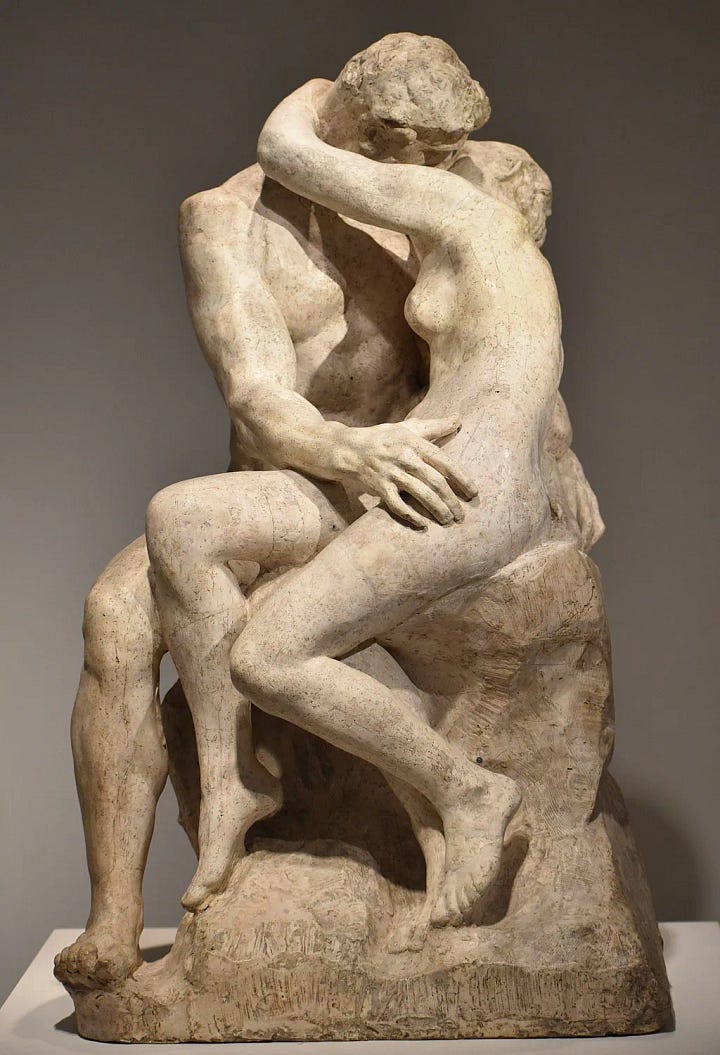
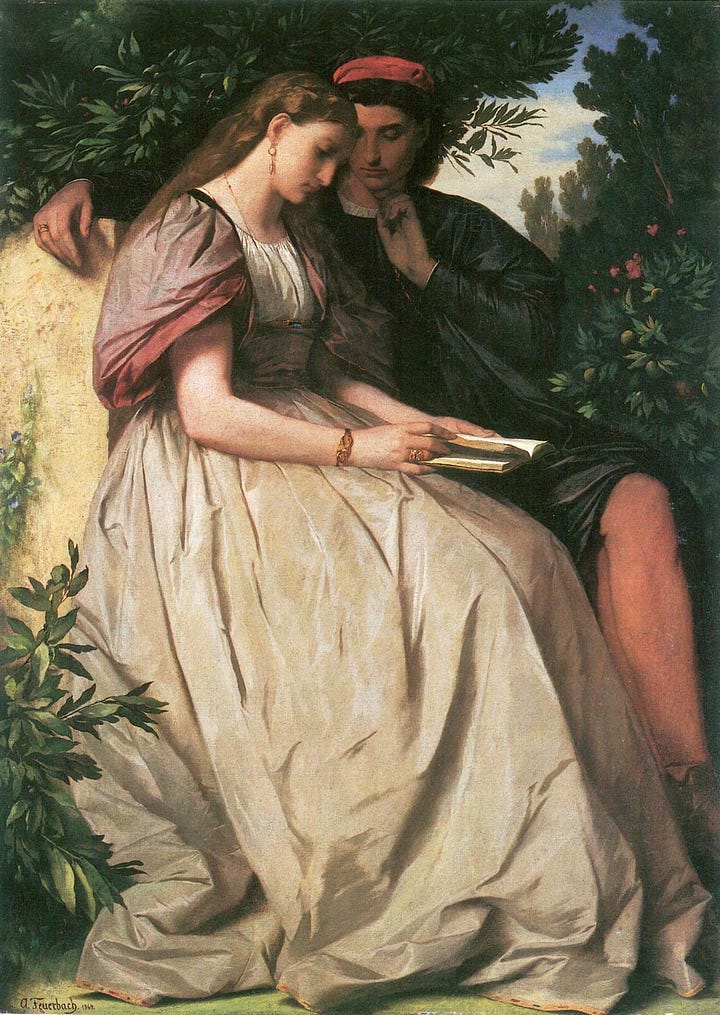
Francesca da Rimini was an Italian noble and daughter of Guido da Polenta. She is famously known for her tragic love affair with Paolo Malatesta. She and her lover were both murdered by her husband after he found out about her adulterous affair. Francesca and Paolo are most famously depicted in Dante’s “The Divine Comedy” in Canto 5 of “Inferno”. While being guided by Virgil, he encounters the lovers in Hell where they are doomed for eternity for succumbing to the sin of lust.
Followers of Romanticism have transformed Francesca’s character from a sinner “into an exemplar of female agency and a cultural icon”. In this article by the Smithsonian, it states that “Dante placed Paolo and Francesca in hell because they allowed their power and passion, their most animal-like quality, to overcome their rationality, the thing that made them human. For the Romantics, however, subsuming reason to the passions was the goal of a life well lived”.
In almost every art piece that I see depicting Francesca and Paolo, I’m met with the visuals of their deep affection for one another, and with the tragedy of what it means to be doomed by fate. I remember seeing Ary Scheffer’s “Francesca da Rimini” piece in the Wallace Collection in London, and something about Francesca’s pose was quite strong in the image. To me, it’s a reflection of her choice, and it’s powerfully acknowledged. While Dante and Virgil stand in the shadows judging the pair, and Paolo seems to be flying in agony, Francesca remains almost content in her expression. She’s the one holding Paolo in her arms as they “fly together as one”.
Personally, I find their story to be incredibly romantic. Francesca and Paolo have transcended time, becoming a source of inspiration to even modern day artists. Hozier’s song “Francesca” is an epic declaration of love from Paolo’s perspective, who originally remains silent in Dante’s “Inferno”. The lyrics “heaven is not fit to house a love like you and I” fully encapsulates the devout love of Francesca and Paolo’s story.
3. A Mother’s Love
A mother’s love can shake the Earth at its core, and still manage to keep the ocean waves calm from its force. It’s a haven. It’s safe. It’s warm. It’s the tip of a sharp blade. Nothing embodies the definition of devotion more than a mother’s love.
In “Chouette” by Claire Oshetsky, the main protagonist, Tiny, gets pregnant and gives birth to an “owl baby”. This novel is an orchestra and a fever dream, that illustrates the story of a mother’s profound love and commitment to her child. The world rejects her owl baby, but Tiny stands defiant against every single odd. She acknowledges her child for what her owl-baby is, and it doesn’t deter her affection.
This is one of the few books that I have read that truly cuts into the ultimate sacrifice of a mother’s love while not shying away from the difficulties of what it means to lose oneself into the life of another. This loss isn’t by choice, but purely by the sheer instinct of being overwhelmed by this internally guided love over another person.
It’s a consumption, it’s parasitic, and it’s incredibly beautiful.
Tiny states to her owl-baby: “It could be that you've injected me with your little talon. It could be that your talon is dipped in the poison of mother-love”.
4. Fruit Bowls
Fruits often symbolize many things including pleasure, temptation, debauchery, purity, and desire. They also quite literally often serve as a metaphor for body and flesh. Darker meanings of this imagery can transcend into conceptual horrors like cannibalism. But in other cases, fruits represent the themes of sensuality, life, death, fertility and rebirth. If I were to pluck out a specific fruit from the bowl of comparisons, one that there seems to be quite abundant in the mix is pomegranates.
Pomegranates is famously traced to the story of Hades and Persephone. Hades was actually Persephone’s uncle, and he abducted Persephone against her will after Zeus permitted him to do so since Persephone’s Mother, Demeter, would not allow her daughter to marry Hades. This abduction has been portrayed by many artists, but one of the most famous representations comes from Gian Lorenzo Bernini’s sculpture: “The Rape of Proserpine”. Bernini’s phenomenal masterpiece is the perfect visual of the distortion surrounding this myth. At angles up close, we see marble turn to skin, with Hades’ touch appearing intimate if you don’t acknowledge any of the above context. And yet, as you stand back to see the full statue, it suddenly dawns on you the terrifying reality that surrounds this pair.
When Zeus demands the return of Persephone, Hades does so only after tricking her into eating pomegranate seeds. This manipulation tactic is what forces her to stay behind in the underworld. Rachel Lyon’s coming-of-age novel “Fruit of the Dead” does a fantastic job with giving us a modern retelling of Hades and Persephone’s story. This retelling highlights addiction, the temptations around a forbidden romance, and the consequences of choices. It draws on the seduction towards darkness without sugar coating the terrors that can be found in its shadows. It also gives us a strong representation of a mother’s love against this, in which “Persphone’s mother” fights tooth and nail to get her daughter back.
As a being, Persephone is the dichotomy of life and death. She is the Goddess of Spring and Queen of the Underworld. Much like the Goddesses of Love mentioned, she easily dances between two polarizing worlds. And like Francesca, her story has been reclaimed to give her back her power. Hades and Persephone don’t stand as a cautionary tale nowadays, because they are romanticized as an unlikely pair who find ardent love in one another. Persephone’s role between the living and dead gives her more agency than her original myth intended, and because of that people have altered her truth into believing that it’s real love that her and Hades share.
They are opposing forces desperately trying to cling onto one another, rather than a pair bound together by one God’s insatiable obsession.

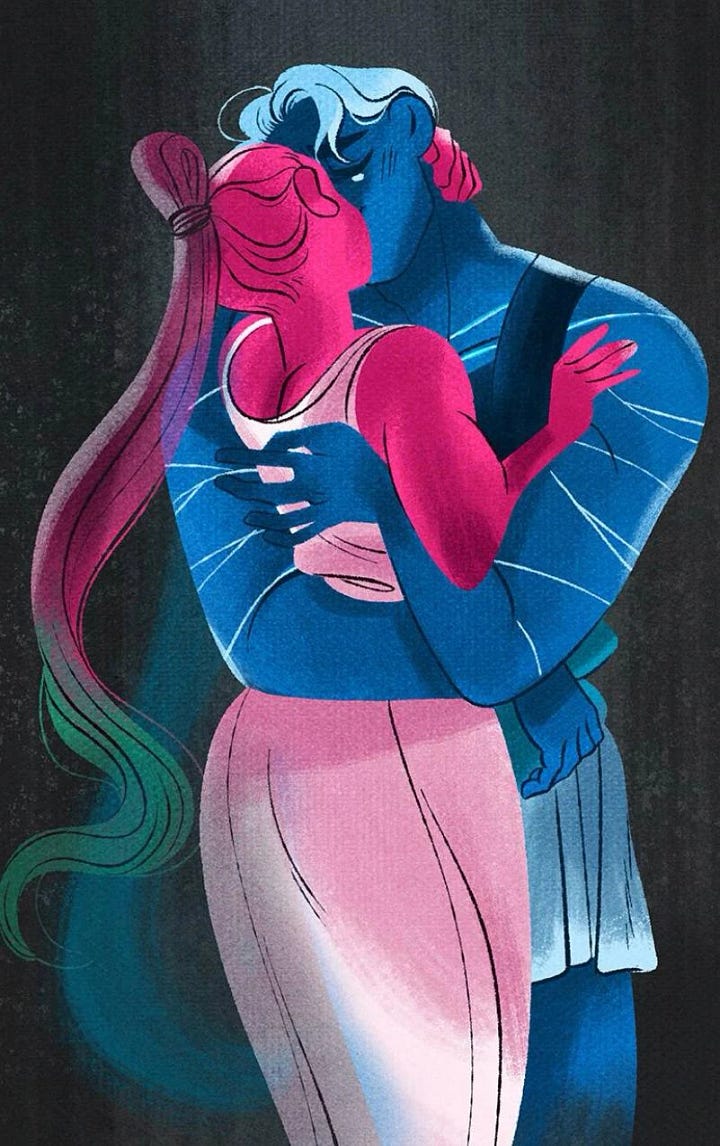
5. Madness & Obsession

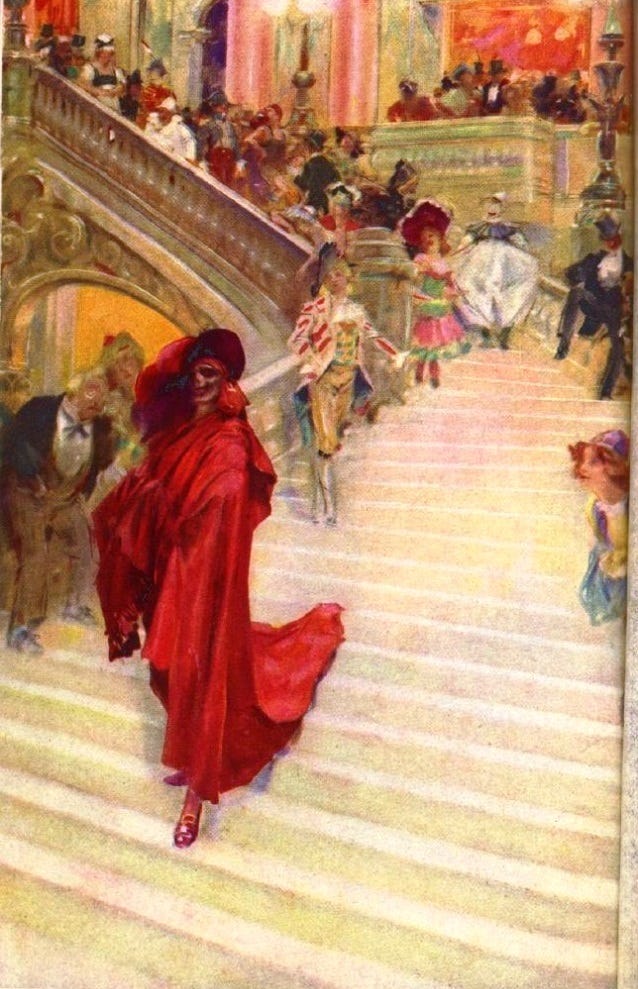
Where there is profound love, there is also a vulnerable crack into one’s soul. It’s the very thin line that can drive a person to the brink of insanity. “Majnun Layla” or “Layla’s Mad Lover” is a story inspired by 7th century Arab poet Qays ibn al Mulawwah and his lover Layla. This is another rendition of star crossed lovers, but where neither ever marry or consummate their passion. The pair simply fell in love while they were young, but once they were older, Layla’s father denied them of being together. As a result, Qays becomes obsessed with her, resulting in his community to call him crazy. Persion poet Nizami Ganjavi popularized their story in Persian literature, and since then there has been many renditions of “Majnun Layla”.
Obsession is an equal affliction. French author Gaston Leroux’s “The Phantom of the Opera” is now a Broadway sensation. This gothic romance is about an opera singer named Christine, who is mentored by a secret music teacher who she calls her “angel of music”. Her teacher in question is actually “The Phantom” who haunts the opera house where she performs, and he grows entirely increasingly obsessed with his protégée. He wreaks havoc, sabotages her rivals, kills those who are against him until he eventually targets Raoul who is Christine’s childhood friend that she starts falling in love with.
Madness and obsession reinforce love’s turbulence. While it’s something that many covet, it can be too powerful for an individual to handle at its full force. It makes you understand why there are deities in place who safeguard the practice to begin with, and why it’s easy for us romantics to drown ourselves in it.
Love is a complication, and the intangible evidence of our human heart.
It’s beautiful and equally as terrifying.
A miracle and a curse.
sources:
“Venus & Aphrodite: The Biography of Desire” by Bettany Hughes
Plaque via The British Museum
“Before Romeo and Juliet - Paolo and Francesca were Literature’s Star-Crossed Lovers”
Ash Scheffers “Francesca di Rimini”
August Rodin’s “The Kiss”
Anselm Feuerbach “Paolo and Francesca”
“Chouette” by Claire Oshetsky
Bernini’s “The Rape of Proserpine”
Graphic Novel: Lore Olympus
"Laila and Majnun in School", Folio 129 from a Khamsa (Quintet) of Nizami of Ganja via The Met
“The Phantom of the Opera” by André Castaigne





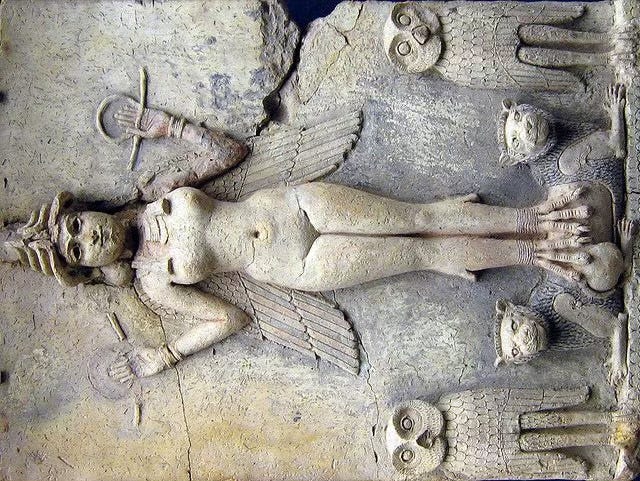
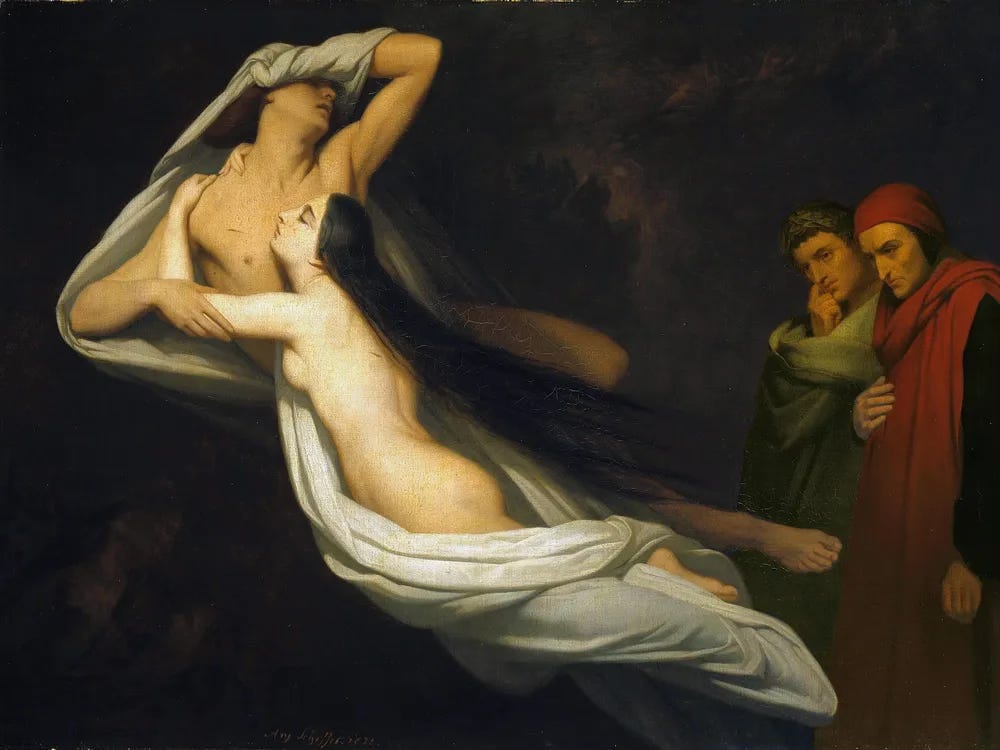
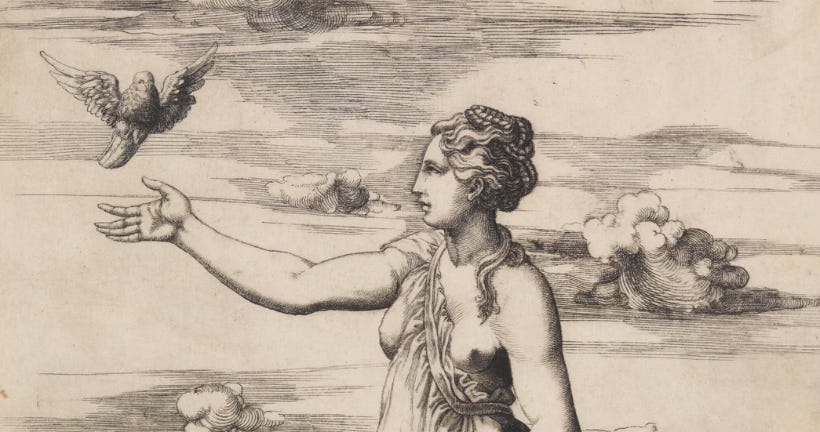
I am addicted to your love letters ❤️ in the case of مجنون ليلى the verse
كأن فؤادي في مخالب طائر كلما ذكرتها شد بي قبضا
The imagery always gutted me.
What gorgeous writing - thank you for sharing your heart so openly. It felt like a journey reading this, exploring all the different little worlds of love.